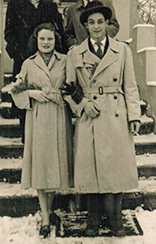Search for Names, Places and Biographies
Already layed Stumbling Stones
Suche
Heinrich Bachert * 1909
Schenkendorfstraße 19 (Hamburg-Nord, Uhlenhorst)
HIER WOHNTE
HEINRICH BACHERT
JG. 1909
VERHAFTET MÄRZ 1945
KZ FUHLSBÜTTEL
GEHENKT 23.4.1945
NEUENGAMME
- http:/
/ de.wikipedia.org/ wiki/ Heinrich_Bachert
(Heinrich Bachert bei Wikipedia)
Paul Heinrich Wilhelm Bachert, born on 25 Mar. 1909, arrested on 7 Mar. 1945 and detained in the Fuhlsbüttel concentration camp; transferred on 23 Apr. 1945 to the Neuengamme concentration camp and murdered there
Schenkendorfstraße 19
The married couple Wilhelm and Henriette Bachert lived in Hamburg and had two sons. Otto was born on 13 Oct. 1903, his brother Heinrich followed on 25 Mar. 1909. The family had a small apartment at Desenissstrasse 7.
Both brothers completed apprenticeships as metalworkers, subsequently becoming fitters. Heinrich found a job as an electrician with the Conz Bahrenfeld Company on Gasstrasse in Altona. Heinrich Bachert found his first apartment at Schenkendorfstrasse 19, where he lived until his arrest.
Heinrich’s father Wilhelm was a Protestant and his wife Henriette, née Levy, was Jewish, with the two sons raised in the Christian faith. However, with the "Nuremberg Laws” on race passed in 1935, Heinrich and Otto became "half-Jews” ("Halbjuden”), suffering from hostilities and persecution. In addition, Heinrich was politically active, participating in the illegal work of Germany’s Communist Party, the KPD.
In his private life, Heinrich had found happiness with Grete Ella Schulz. She was three years his junior, Protestant, and a native of Hamburg as well. Engaged since 1938, they faced considerable hostilities, though, the reason why no marriage came about for the time being.
On 4 Mar. 1944, their only child, Heidi Henny, was born. However, in the fall of that year, the family sustained the next heavy blow. Heinrich lost his job on 1 Oct. because he was a "half-Jew” ("Halbjude”) and his political convictions became known. By then, he was also participating in the work of the "Bästlein-Jacob-Abshagen” group, a resistance organization in Hamburg.
The Gestapo took notice of Heinrich Bachert in early 1945, arresting him on racial and political grounds on 7 Mar. He was imprisoned at Fuhlsbüttel. Grete hoped to be able to help her fiancé by way of marriage. For that reason, they got married on 1 Apr. 1945, even though this was actually prohibited to them. "Half-Jews” were forbidden from marrying "non-Jews” without special permit, and such a permit was granted only in very rare instances. Just how Heinrich and Grete Bachert succeeded nevertheless in getting married is not known.
Heinrich Bachert was transferred from Fuhlsbüttel to the Neuengamme concentration camp on 23 Apr. 1945. Since then there has not been any trace of him, and he was probably hanged there without any sentence.
His mother Henriette Bachert already died on 3 July 1940 in Hamburg, her husband followed on 3 Aug. 1951. Otto and his wife Hanna survived the Holocaust. Heinrich’s wife Grete and their daughter Heidi also lived through the Second World War. In 1953, Grete remarried and lived in Winterhude.
Translator: Erwin Fink
Kindly supported by the Hermann Reemtsma Stiftung, Hamburg.
© Carmen Smiatacz und Johannes Grossmann
Quellen: StaH 351-11, Amt für Wiedergutmachung, Abl. 2008/1, 040344 (Heidi Bachert); ebd. Abl. 2008/1, 53395; ebd._37701 (Grete Waitszies); StaH 332-8, Meldewesen, K2412, K2406; Standesamt HH1, Nr. 420/1944 (Heidi Bachert); ebd., Nr. 75/1946 (Eheschließung); Herbert Diercks, Gedenkbuch "Kola-Fu"/Für die Opfer aus dem Konzentrationslager, Gestapo-Gefängnis und KZ-Außenlager Fuhlsbüttel, (Hrsg.) Gedenkstätte Neuengamme, Hamburg 1987, S. 51; Ursel Hochmuth/Gertrud Meyer, Streiflichter aus dem Hamburger Widerstand 1933–1945, München 1980, S. 386; KZ-Gedenkstätte Neuengamme, Totenbuch, Hrsg. Freundeskreis e.V., Hamburg 1967; Totenbuch Hamburger Widerstandskämpfer und Verfolgter 1933–1945, (Hrsg.) Willi Sander, Hamburg 1968; Für Freiheit und Demokratie/Hamburger Sozialdemokratinnen und Sozialdemokraten in Verfolgung und Widerstand 1933–1945, (Hrsg.) SPD LO Hamburg, AK Geschichte, AvS Hamburg 2003; Johannes Grossmann, Die letzten Toten von Neuengamme, Hamburger Abendblatt Magazin, Nr. 14/2015, siehe auch www.stolpersteine-hamburg.de/Dokumentationen; Privatarchiv Heidi Bachert-Kese/Manfred Kese; telefonische und E-Mail-Kontakte mit Manfred Kese, Dezember 2016/Januar 2017; Herbert Diercks, Der Einsatz von V-Leuten im Sachgebiet "Kommunismus" der Hamburger Gestapo 1943–1945, in: KZ Gedenkstätte Neuengamme (Hrsg.), Polizei, Verfolgung und Gesellschaft im Nationalsozialismus (=Beiträge zur Geschichte der nationalsozialistischen Verfolgung in Norddeutschland, Bd. 15/2013), S. 119–135.


